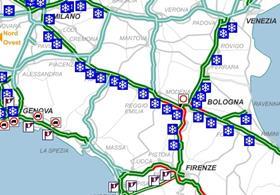
Much of Italy has been struck by heavy, wintry weather during the past couple of days, with snow and ice causing major disruption to over 1,000km of the motorway network in the northern half of the country and rainy, blustery conditions causing an estimated €200m worth of damage to production of fruit and vegetables in the south.
More than 60cm of snow fell on the A1 – known to Italians as the Autostrada del Sole (Motorway of the Sun) – sending shivers down the spine of Italy's road network which links Milan in the north with Naples in the south via Bologna, Florence and Rome.
On Tuesday night, Italy's leading production area for fresh fruit Emilia-Romagna was hit by what was described by weather news website MeteoGiornale.it as 'an intense storm, which at times had all the characteristics of a blizzard'.
The snowfall resulted in the closure of Bologna's Marconi airport at 4:50pm Tuesday (9 March). Officials were due to assess the state of the airport at 12am on Wednesday (10 March) before deciding whether or not to resume operations.
By this morning, around 10-20cm of snow had fallen in parts of Romagna and as much as 30-40cm in neighbouring Emilia, with total snowfall eclipsing the previous record levels not seen since 1985. Fresh produce sales in Bologna and Parma slowed as a result ofthe snowfall, sources suggested.
'From what I know, the biggest problems today and tomorrow are set to be logistical ones,' said Alberto Montanari of leading Italian packaging firm ILIP. 'Our shipments have stopped for now and I believe across the whole of the southern part Emilia and Romagna it's very difficult for anyone to move.'
Elsewhere in the north, snow was set to continue falling. 'It's snowing here now,' reported Stefano Pezzo of import-export group Cherry Passion, based Verona, north-east Italy. 'The main problem is in the north-west, where trucks from Spain have been unable to enter. As a result, goods are being blocked.'
In southern Spain and France, snowy conditions have also had a major impact on the transport network, with members of the fresh produce industry telling Fruitnet.com that the impact on their operations had been significant.
However, leading soft fruit producer Sant'Orsola, which has growing areas in Trentino and Veneto in the north-east of Italy as well as in Campania in the south, told Fruitnet.com that the snowy conditions were not expected to have a major impact on production in the north of Italy.
'We haven't had any problems as a result of this sudden snowfall,' said Sara Bellini, marketing manager at Sant'Orsola, 'either from a production point of view (in fact, the snow covers the plants and protects them from any risk of freezing) or from the point of view of distributing the products – except from the little problem seen in various parts of Italy being reported in the news over the past few days.'
Southern exposure
Meanwhile, in the south of the country, heavy rain and strong winds reportedly prompted a spike in demand for vegetables as production suffered.
'The bad weather, with widespread ice and violent Siberian winds, has had consequences for fruit trees including apricots, plums, cherries and peaches in various areas, above all in the south,' said a spokesperson for Italian farming association CIA. 'Some of this production, unfortunately, has been lost.'
The association, which said its provisional estimate of the extent of the damage was in the region of €200m, reported a similar situation for vegetable growers in the south of Italy.
'In fields that are open to the elements, ice has provided a difficult test for various products, especially during the early hours of the morning,' the spokesperson said. 'Damage has been done above all to some types of salad, to broccoli and to artichokes.'
Production costs are set to rise as a result of an anticipated increase in fuel consumption to heat glasshouses and nurseries, the association added. Producers are no longer entitled to zero excise duty on fuel, as they were in the past.
High winds
At the top of the Adriatic Sea, ships were reportedly unable to enter or leave the Italian port of Trieste as a result of a northerly wind referred to in the region as the Bora.
Averaging around 100kmh from Tuesday (9 March) afternoon onwards, by Wednesday the wind speed at the port had topped 152kmh, according to weather observatory Arpa, the highest since records began in the 1990s.
The blustery conditions also caused problems for cargo ships, with one running aground near the Port of Taranto in Puglia and another in distress off the coast of Sardinia.
Snow was set to continue falling until late afternoon today across much of the north of Italy, with levels of settled snow on the ground reaching an estimated 50-70cm.
Rain, meanwhile, was forecast for the southern regions of Calabria, Basilicata and Puglia.



